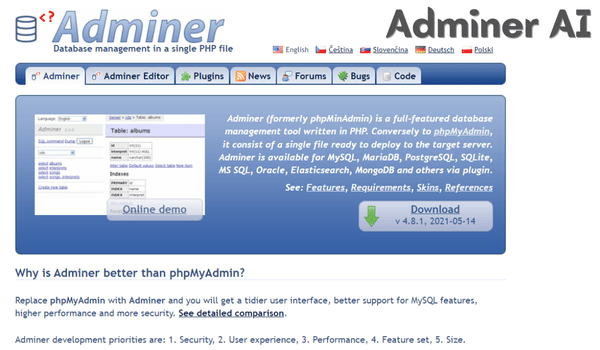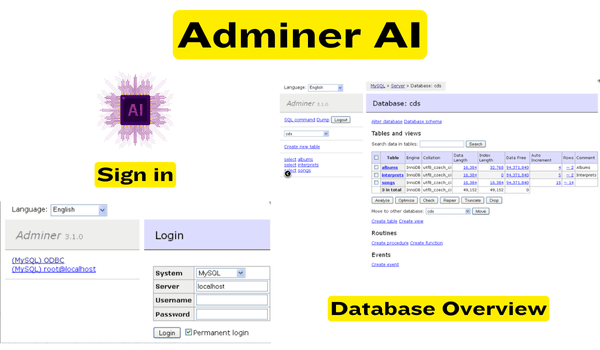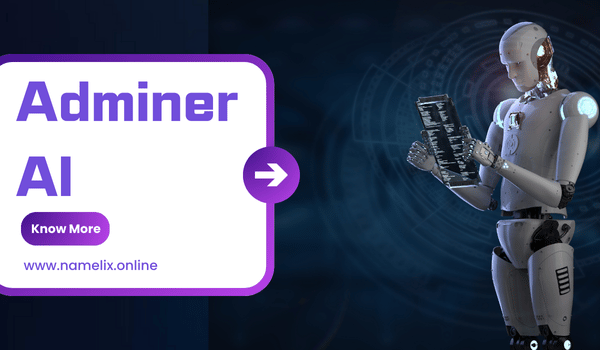Adminer is a powerful tool for managing databases. It’s like a Swiss Army knife for database administrators and developers. This free, open-source software lets you handle various database systems through a simple web interface. Whether you’re working with MySQL, PostgreSQL, or SQLite, Adminer has got you covered.
In this article, we’ll dive deep into Adminer’s features, how it works, and why it’s become a go-to choice for many. We’ll also look at some alternatives and answer common questions. If you’re dealing with databases and want an easier way to manage them, keep reading. Adminer might just be the tool you’ve been looking for.

What is Adminer?
Adminer is a full-featured database management tool. It’s written in PHP and can be used with many different database systems. These include MySQL, PostgreSQL, SQLite, MS SQL, Oracle, Elasticsearch, and MongoDB. It is like a lightweight version of phpMyAdmin but with some extra perks.
One of the best things about Adminer is how easy it is to use. You don’t need to install anything complicated. Just upload a single PHP file to your server, and you’re good to go. This makes it super handy for quick database tasks.
Lets you do all sorts of things with your databases. You can create, edit, and delete tables. You can run SQL queries, import and export data, and manage users. It even has features for more advanced users, like working with stored procedures and triggers.
The tool is designed to be secure and efficient. It uses parameterized queries to prevent SQL injection attacks. It also has a clean, simple interface that loads quickly. This makes it a great choice for both beginners and experienced database admins.
How Does Adminer Work?
Adminer works by providing a web-based interface to your database. Here’s a simple breakdown of how it operates:
- Installation: You start by uploading the Adminer PHP file to your web server. This file contains all the code needed to run Adminer.
- Access: You then access through a web browser. Just navigate to the URL where you uploaded the file.
- Login: When you open it, you’ll see a login screen. Here, you enter your database credentials.
- Connection: Once you log in, Adminer connects to your database server using the details you provided.
- Interface: After connecting, you’ll see the main interface. This shows your databases and tables.
- Operations: From here, you can perform various database operations. These include viewing and editing data, running queries, and managing database structures.
- Security: Adminer uses secure methods to interact with your database. It helps protect against common security threats.
- Execution: When you act, It translates it into the appropriate SQL commands. It then sends these to your database server.
- Results: The results of your actions are displayed in the Adminer interface. This could be table data, query results, or confirmation messages.
Adminer’s simplicity is one of its strongest points. It’s easy to set up and use, making database management tasks much more straightforward.

How to Use Adminer
Using Adminer is pretty straightforward. Here’s a step-by-step guide to get you started:
- Download Adminer:
- Go to the official Adminer website.
- Download the PHP file for your database system.
- Upload to Server:
- Upload the Adminer PHP file to your web server.
- You can rename it if you want, like “adminer.php”.
- Access Adminer:
- Open a web browser.
- Go to the URL where you uploaded the file (e.g., “http://yoursite.com/adminer.php”).
- Login:
- You’ll see a login screen.
- Enter your database server, username, and password.
- Select your database system (MySQL, PostgreSQL, etc.).
- Click “Login”.
- Navigate the Interface:
- On the left, you’ll see a list of your databases.
- Click on a database to see its tables.
- Click on a table to view or edit its data.
- Perform Operations:
- Use the top menu to create new tables, run SQL queries, or import/export data.
- Click on table names to edit their structure or data.
- Use the “SQL command” option to run custom queries.
- Manage Users:
- Look for the “Privileges” option to manage database users.
- Logout:
- When done, always click “Logout” for security.
Remember, Adminer is powerful. Be careful when making changes to your database. It’s always a good idea to have a backup before doing major operations.
Key Features of Adminer
Adminer comes packed with features that make database management easier. Here are some of its key offerings:
1. Multi-Database Support
- Works with MySQL, PostgreSQL, SQLite, MS SQL, Oracle, and more.
- Switch between different database systems easily.

2. Single File
- The entire application is in one PHP file.
- Easy to upload and use on any server with PHP.
3. User-Friendly Interface
- Clean, intuitive design.
- Easy navigation between databases and tables.
4. Table Operations
- Create, alter, and drop tables.
- Manage indexes and foreign keys.
5. Data Manipulation
- View, edit, insert, and delete records.
- Bulk editing and deleting.
6. SQL Query Execution
- Run custom SQL queries.
- View query history.
7. Import and Export
- Import data from CSV and SQL files.
- Export data in various formats (SQL, CSV, XML).
8. User Management
- Create and manage database users.
- Set user privileges.
9. Security Features
- Uses parameterized queries to prevent SQL injection.
- CSRF protection.
10. Customization
- Adminer themes for changing the look.
- Plugins to extend functionality.
These features make Adminer a versatile tool for both simple and complex database tasks.
Adminer Pricing
One of the best things about Adminer is its pricing – it’s completely free! Here’s what you need to know about Adminer’s cost:

- Free and Open Source: Adminer is 100% free to use. You can download and use it without paying anything.
- No Hidden Costs: There are no premium versions or paid features. Everything is available for free.
- Open Source License: It is released under the Apache License 2.0 or GPL 2. This means you can use, modify, and distribute it freely.
- No Subscription Fees: Unlike some database tools, there are no monthly or yearly fees.
- Free Updates: New versions and updates are also free.
- Community Support: While there’s no paid support, you can get help from the community for free.
- Optional Donations: If you find it useful, you can make a voluntary donation to support its development.
The fact that Adminer is free doesn’t mean it’s low quality. It’s a robust, professional-grade tool that just happens to be open source. This makes it a great option for individuals, small businesses, and even large companies looking to manage their databases without breaking the bank.
Pros and Cons
Pros:
- Free and open-source
- Single file installation
- Supports multiple database systems
- User-friendly interface
- Lightweight and fast
- Regular updates and improvements
- Secure with features like parameterized queries
- Customizable with themes and plugins
- No need for separate installation on the server
Cons:
- Less feature-rich compared to some paid alternatives
- May lack advanced features needed for very large databases
- Limited official support (relies on community support)
- Not as well-known as some other database management tools
- Might be too simple for some advanced users
- Requires PHP to be installed on the server
- Limited reporting and analytics features
- No built-in scheduling for backups or tasks
What Makes Adminer Unique?
Adminer stands out in the world of database management tools for several reasons:
- Single File Simplicity: Adminer’s entire application is contained in a single PHP file. This makes it incredibly easy to deploy and use. You don’t need to go through complex installation processes. Just upload one file, and you’re ready to go.
- Multi-Database Support: Unlike some tools that focus on just one database system, Adminer works with many. Whether you’re using MySQL, PostgreSQL, SQLite, or others, It has you covered. This versatility is a big plus for developers who work with different database types.
- Lightweight Yet Powerful: Adminer manages to pack a lot of features into a small package. It’s lightweight, which means it loads quickly and doesn’t use much server resources. But it still offers powerful database management capabilities.
- Open Source Freedom: Being open source, It can be customized and improved by the community. This leads to regular updates and new features. It also means you can modify it to fit your specific needs if you have the skills.
These unique aspects make Adminer a favorite among many developers and database administrators. It offers a balance of simplicity, power, and flexibility that’s hard to find in other tools.
Adminer Login and Sign Up

Adminer doesn’t have a traditional sign-up process. Instead, you use your database credentials to log in. Here’s a simple guide:
- Open Adminer:
- Go to the URL where you uploaded the Adminer PHP file.
- Choose Database System:
- Select your database type (MySQL, PostgreSQL, etc.) from the dropdown.
- Enter Server Details:
- Type in your database server address (often “localhost”).
- Provide Username:
- Enter the username for your database.
- Enter Password:
- Type in your database password.
- Select Database (Optional):
- You can choose a specific database or leave this blank.
- Click Login:
- Hit the “Login” button to access your database.
- First-Time Security:
- If it’s your first time, you might see a security warning. This is normal.
- Start Using Adminer:
- Once logged in, you can start managing your database.
Remember, Adminer uses your existing database credentials. There’s no separate Adminer account to create. This makes it simple to use but also means you need to know your database login details.
Limitations Of Adminer
While Adminer is a great tool, it does have some limitations:
- Limited Advanced Features: It might lack some advanced features found in more comprehensive tools. This can be an issue for complex database management tasks.
- No Built-in Backup Scheduling: You can’t schedule automatic backups within Adminer. This means you need to handle backups manually or use another tool.
- Basic Reporting: If you need detailed database reports or analytics, Adminer’s capabilities are limited. You might need additional tools for in-depth analysis.
- Single-User Focus: Adminer is designed for individual use. It doesn’t have features for team collaboration or user role management within the tool itself.
- Dependency on PHP: It requires PHP to be installed on your server. This might be a limitation in some environments.
- Limited Official Support: Since it’s a free, open-source tool, there’s no official paid support. You’ll need to rely on community forums for help.
- Simple Interface: While its simplicity is often an advantage, some users might find the interface too basic for their needs.
- Performance with Large Databases: For very large databases, Adminer might not be as efficient as some specialized tools.
Despite these limitations, Adminer remains a popular choice for many users due to its simplicity and ease of use.

Alternatives For Adminer
If you’re looking for tools similar to Adminer:
- phpMyAdmin:
A free, web-based tool for managing MySQL and MariaDB databases. It’s been around for a long time and has a large user base. phpMyAdmin offers a comprehensive set of features for database administration. - DBeaver:
An open-source, universal database tool. DBeaver supports many database systems and provides a rich user interface. It’s available as both a desktop application and a web-based version. - HeidiSQL:
A free tool for managing MySQL, MariaDB, and Microsoft SQL Server databases. HeidiSQL offers a user-friendly interface and is known for its speed and efficiency. - SQLyog:
A powerful MySQL GUI tool with both free and paid versions. SQLyog provides advanced features like query profiling and data synchronization. It’s particularly popular among MySQL developers. - pgAdmin:
An open-source administration and management tool for PostgreSQL databases. pgAdmin offers a web-based interface and is the most popular tool for managing PostgreSQL databases. - Anyword AI:
Anyword uses AI to write high-performing marketing copy, like website text, social media posts & ads. It analyzes data to suggest improvements & optimize your content for conversions.
FAQs
Adminer docker is a containerized version of it. It allows you to run it in a Docker container, making it easy to deploy and manage in various environments.
To use Adminer with PostgreSQL, select “PostgreSQL” from the system dropdown on the login page. Then enter your PostgreSQL server details, username, and password to connect.
There was a security vulnerability in Adminer 4.8.1. It’s important to always use the latest version of it to ensure you have the most recent security updates.
Yes, Adminer supports themes. You can find and apply various themes to change its look and feel to suit your preferences.
Some popular alternatives to it include phpMyAdmin, DBeaver, HeidiSQL, SQLyog, and pgAdmin. Each has its strengths and may be better suited for specific needs.
Conclusion
Adminer is a powerful, lightweight tool for database management. Its simplicity and versatility make it a great choice for many users. From its easy single-file installation to support for multiple database systems, It offers a lot. While it has some limitations, its free and open-source nature makes it accessible to all.
Whether you’re a beginner or an experienced database admin, It can simplify your database tasks. As with any tool, it’s worth trying out to see if it fits your needs. Remember to always keep it updated for the best performance and security. Happy database managing!
